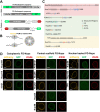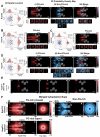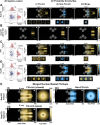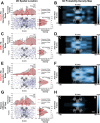This is a preprint.
Exploring Cellular Gateways: Unraveling the Secrets of Disordered Proteins within Live Nuclear Pores
- PMID: 38260360
- PMCID: PMC10802689
- DOI: 10.21203/rs.3.rs-3504130/v1
Exploring Cellular Gateways: Unraveling the Secrets of Disordered Proteins within Live Nuclear Pores
Abstract
Understanding the spatial organization of nucleoporins (Nups) with intrinsically disordered domains within the nuclear pore complex (NPC) is crucial for deciphering eukaryotic nucleocytoplasmic transport. Leveraging high-speed 2D single-molecule tracking and virtual 3D super-resolution microscopy in live HeLa cells, we investigated the spatial distribution of all eleven phenylalanine-glycine (FG)-rich Nups within individual NPCs. Our study reveals a nuanced landscape of FG-Nup conformations and arrangements. Five FG-Nups are steadfastly anchored at the NPC scaffold, collectively shaping a central doughnut-shaped channel, while six others exhibit heightened flexibility, extending towards the cytoplasmic and nucleoplasmic regions. Intriguingly, Nup214 and Nup153 contribute to cap-like structures that dynamically alternate between open and closed states along the nucleocytoplasmic transport axis, impacting the cytoplasmic and nuclear sides, respectively. Furthermore, Nup98, concentrated at the scaffold region, extends throughout the entire NPC while overlapping with other FG-Nups. Together, these eleven FG-Nups compose a versatile, capped trichoid channel spanning approximately 270 nm across the nuclear envelope. This adaptable trichoid channel facilitates a spectrum of pathways for passive diffusion and facilitated nucleocytoplasmic transport. Our comprehensive mapping of FG-Nup organization within live NPCs offers a unifying mechanism accommodating multiple transport pathways, thereby advancing our understanding of cellular transport processes.
Keywords: FG-Nups; Hydrophobic interaction; Intrinsically disordered proteins; Live cell imaging; Nuclear pore complexes; Nuclear pore structure; Nucleocytoplasmic transport; Nucleoporins; Single-molecule tracking; Super-resolution light microscopy; Three-dimensional microscopy imaging.
Conflict of interest statement
Declaration of interests The authors declare that they have no competing financial interests.
Figures







Similar articles
-
Assembly of Nsp1 nucleoporins provides insight into nuclear pore complex gating.PLoS Comput Biol. 2014 Mar 13;10(3):e1003488. doi: 10.1371/journal.pcbi.1003488. eCollection 2014 Mar. PLoS Comput Biol. 2014. PMID: 24626154 Free PMC article.
-
AI-based structure prediction empowers integrative structural analysis of human nuclear pores.Science. 2022 Jun 10;376(6598):eabm9506. doi: 10.1126/science.abm9506. Epub 2022 Jun 10. Science. 2022. PMID: 35679397
-
Super-resolution 3D tomography of interactions and competition in the nuclear pore complex.Nat Struct Mol Biol. 2016 Mar;23(3):239-47. doi: 10.1038/nsmb.3174. Epub 2016 Feb 15. Nat Struct Mol Biol. 2016. PMID: 26878241 Free PMC article.
-
The selective permeability barrier in the nuclear pore complex.Nucleus. 2016 Sep 2;7(5):430-446. doi: 10.1080/19491034.2016.1238997. Epub 2016 Sep 27. Nucleus. 2016. PMID: 27673359 Free PMC article. Review.
-
Deciphering the intrinsically disordered characteristics of the FG-Nups through the lens of polymer physics.Nucleus. 2024 Dec;15(1):2399247. doi: 10.1080/19491034.2024.2399247. Epub 2024 Sep 16. Nucleus. 2024. PMID: 39282864 Free PMC article. Review.
References
-
- Fahrenkrog B. & Aebi U. The nuclear pore complex: nucleocytoplasmic transport and beyond. Nature Reviews Molecular Cell Biology 4, 757–766 (2003). - PubMed
Publication types
Grants and funding
LinkOut - more resources
Full Text Sources
Research Materials
Miscellaneous

